Thessaloniki gets ready for its metro launch in November
The underground rapid transit lines have been under construction for almost two decades due to various project delays
 TheMayor.EU logo
TheMayor.EU logo 
The actual charter that granted toll privileges to Amsterdammers when they travel, Source: Amsterdam City Archives
It has to do with a medieval count by the name of Floris V
Many European cities know the year when they were granted city rights, usually through a document called a charter, but not that many know the exact date of that momentous event. Amsterdam is one of those lucky few, it seems.
Every year, on 27 October, the Dutch capital marks its birthday basing this claim on a document from the distant 1275. Back then, the Count of Holland, Floris V, granted toll privilege to the residents “at the dam in the Amstel River” (apud Amestelledamme).
The toll privilege actually predates the city charter itself, which was granted by the Bishop of Utrecht in 1300 or 1306. The road toll document, however, recognized the residents of the Dam as a community with special rights. The privilege meant that they could travel freely through the county without having to pay any fees at bridges and canal locks.
The ship captains or merchants carried a toll letter, which was an official copy of the count’s document. The toll privilege stayed until 1795.
This came in recognition of the settlement’s increased importance at the mouth of the Amstel River. Early on, its residents had turned to trading using their strategic location to make the most of the passing traffic. It looks like entrepreneurial spirit has been encoded in the Amsterdammers' bloodstream since the origins of their city.
The Dam in the name refers to the actual dam, which was built five to ten years before the granting of the privilege, and it gradually turned into the beating heart of the city. Today, this is where the Dam Square is located.
Amsterdammers had become a business community one had to reckon with, feudal lords and bishops notwithstanding. The valuable document that recognized that first right is a certificate that is preserved in the City Archives, and it’s the one you can see in the photo.
Thus, on 27 October 2025, Amsterdam turns 750 years!

The underground rapid transit lines have been under construction for almost two decades due to various project delays

Now you can get your wine in Talence by paying directly in Bitcoin

That’s because the state has to spend money on updating the railway infrastructure rather than subsidizing the cost of the popular pass

Rethinking renewable energy sources for the urban landscape

The examples, compiled by Beyond Fossil Fuels, can inform and inspire communities and entrepreneurs that still feel trepidation at the prospect of energy transition

Now you can get your wine in Talence by paying directly in Bitcoin

The 10th European Conference on Sustainable Cities and Towns (ESCT) sets the stage for stronger cooperation between the EU, national and local level to fast track Europe's transition to climate neutrality.

At least, that’s the promise made by the mayor of Paris, Anne Hidalgo

The underground rapid transit lines have been under construction for almost two decades due to various project delays

At least, that’s the promise made by the mayor of Paris, Anne Hidalgo

Hostal de Pinós is located in the geographical centre of the autonomous region

Despite its church-y name, the district has long been known as the hangout spot for the artsy crowds

Urban dwellers across the EU are having a say in making their surroundings friendlier to people and the environment.

Forests in the EU can help green the European construction industry and bolster a continent-wide push for architectural improvements.

Apply by 10 November and do your part for the transformation of European public spaces

An interview with the Mayor of a Polish city that seeks to reinvent itself

An interview with the newly elected ICLEI President and Mayor of Malmö

A conversation with the Mayor of Lisbon about the spirit and dimensions of innovation present in the Portuguese capital














